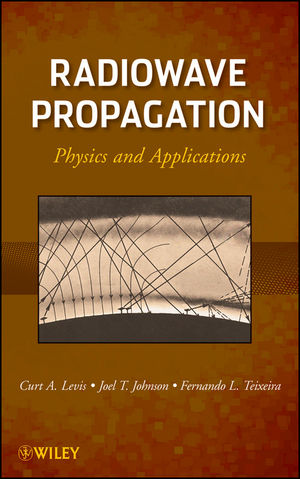Radiowave Propagation: Physics and ApplicationsISBN: 978-0-470-54295-8
Hardcover
320 pages
June 2010
 This is a Print-on-Demand title. It will be printed specifically to fill your order. Please allow an additional 10-15 days delivery time. The book is not returnable.
|
||||||
1 Introduction.
1.1 Definition of Propagation.
1.2 Propagation and Systems Design.
1.3 Historical Perspective.
1.4 The Influence of Signal Frequency and Environment.
1.5 Propagation Mechanisms.
1.6 Summary.
1.7 Sources of Further Information.
1.8 Overview of Text.
2 Characterization of Propagation Media.
2.1 Introduction.
2.2 Maxwell’s Equations, Boundary Conditions, and Continuity.
2.3 Constitutive Relations.
2.4 Dielectric Behavior of Materials: Material Polarization.
2.5 Material Properties.
2.5.1 Simple Media.
2.6 Magnetic and Conductive Behavior of Materials.
References.
3 Plane Waves.
3.1 Introduction.
3.2 D’Alembert’s Solution.
3.3 Pure Traveling Waves.
3.4 Information Transmission.
3.5 Sinusoidal Time Dependence in an Ideal Medium.
3.6 Plane Waves in Lossy and Dispersive Media.
3.7 Phase and Group Velocity.
3.8 Wave Polarization.
References.
4 Antenna and Noise Concepts.
4.1 Introduction.
4.2 Antenna Concepts.
4.3 Basic Parameters of Antennas.
4.3.1 Receiving Antennas.
4.4 Noise Considerations.
References.
5 Direct Transmission.
5.1 Introduction.
5.2 Friis Transmission Formula.
5.3 Atmospheric Gas Attenuation Effects.
5.4 Rain Attenuation.
5.5 Scintillations.
Appendix 5.A Look Angles to Geostationary Satellites.
References.
6 Reflection and Refraction.
6.1 Introduction.
6.2 Reflection from a Planar Interface: Normal Incidence.
6.3 Reflection from a Planar Interface: Oblique Incidence.
6.4 Total Reflection and Critical Angle.
6.5 Refraction in a Stratified Medium.
6.6 Refraction Over a Spherical Earth.
6.7 Refraction in the Earth’s Atmosphere.
6.8 Ducting.
6.9 Ray-Tracing Methods.
References.
7 Terrain Reflection and Diffraction.
7.1 Introduction.
7.2 Propagation Over a Plane Earth.
7.3 Fresnel Zones.
7.4 Earth Curvature and Path Profile Construction.
7.5 Microwave Link Design.
7.6 Path Loss Analysis Examples.
7.7 Numerical Methods for Path Loss Analysis.
7.8 Conclusion.
References.
8 Empirical Path Loss and Fading Models.
8.1 Introduction.
8.2 Empirical Path Loss Models.
8.3 Signal Fading.
8.4 Narrowband Fading Mitigation Using Diversity Schemes.
8.5 Wideband Channels.
8.6 Conclusion.
References.
9 Groundwave Propagation.
9.1 Introduction.
9.2 Planar Earth Groundwave Prediction.
9.3 Spherical Earth Groundwave Prediction.
9.4 Methods for Approximate Calculations.
9.5 A 1 MHz Sample Calculation.
9.6 A 10 MHz Sample Calculation.
9.7 ITU Information and Other Resources.
9.8 Summary.
Appendix 9.A Spherical Earth Groundwave Computations.
References.
10 Characteristics of the Ionosphere.
10.1 Introduction.
10.2 The Barometric Law.
10.3 Chapman’s Theory.
10.4 Structure of the Ionosphere.
10.5 Variability of the Ionosphere.
References.
11 Ionospheric Propagation.
11.1 Introduction.
11.2 Dielectric Properties of an Ionized Medium.
11.3 Propagation in a Magnetoionic Medium.
11.4 Ionospheric Propagation Characteristics.
11.5 Ionospheric Sounding.
11.6 The Secant Law.
11.7 Transmission Curves.
11.8 Breit and Tuve’s Theorem.
11.9 Martyn’s Theorem on Equivalent Virtual Heights.
11.10 MUF, "Skip" Distance, and Ionospheric Signal Dispersion.
11.11 Earth Curvature Effects and Ray-Tracing Techniques.
11.12 Ionospheric Propagation Prediction Tools.
11.13 Ionospheric Absorption.
11.14 Ionospheric Effects on Earth–Space Links.
References.
12 Other Propagation Mechanisms and Applications.
12.1 Introduction.
12.2 Tropospheric Scatter.
12.3 Meteor Scatter.
12.4 Tropospheric Delay in Global Satellite Navigation Systems.
12.5 Propagation Effects on Radar Systems.
References.
Index.



